Also known as the “sleeping shark,” the Greenland shark is a massive predator and the longest-living vertebrate known to science.
It can grow up to 6.4 meters in length and can live over 500 years, typically inhabiting areas deeper than 2,200 meters and in icy waters.
Despite its enormous size and long lifespan, very little is actually known about this shark species.
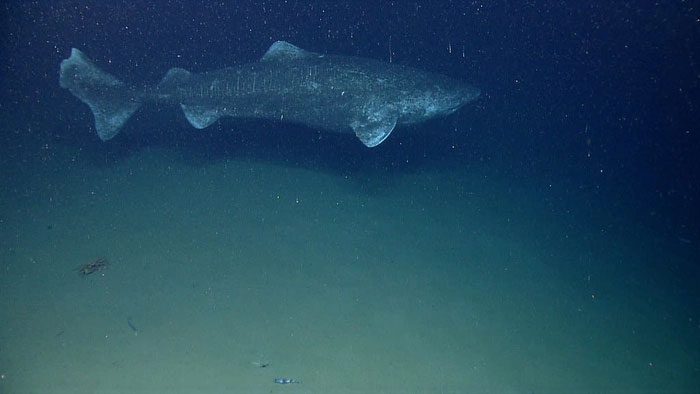
Greenland sharks can live for over 500 years.
Contrary to Evolutionary Trends of Other Shark Species
Sharks have been evolving for about 450 million years, long before dinosaurs or even trees appeared. The Greenland shark is part of an ancient family of sharks that is over 100 million years old. This family is known as Somniosidae, named after Somnus, the Roman god of sleep.
They are referred to as sleeping sharks because they move very slowly in the water. The Greenland shark (Somniosus microcephalus) typically swims at a speed of about 1.2 km/h, with its fastest recorded speed reaching only 2.6 km/h. This speed is slower than most seal and fish species, leading some researchers to question how they hunt.
In addition to their sluggish speed, their eyesight is often impaired due to parasites attacking their eyes. This means that Greenland sharks have nearly no vision – but they can still navigate using their sense of smell.
In fact, most Greenland sharks are believed to be infected with parasites (a species of copepod known as Ommatokoita elongata) that affect their eyesight. Some researchers even speculate that because this parasite may bioluminesce, it could form a mutual relationship with the Greenland shark by attracting prey, although this has not been confirmed.
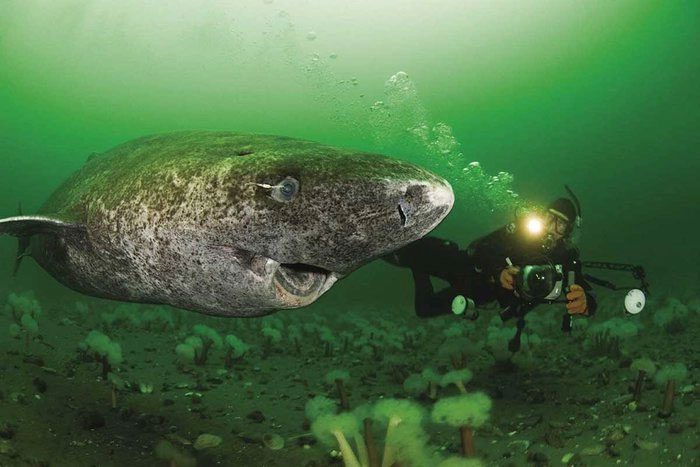
Some shark species, including the Greenland shark, can remain motionless for a time.
The Greenland shark also contradicts a common belief about sharks: that they need to swim continuously. In reality, some shark species, including the Greenland shark, can remain motionless for periods.
Most shark species must swim continuously to bring oxygen-rich water over their gills, but some can still breathe while stationary. The circulatory system of the Greenland shark is specially adapted for this, enabling it to extract oxygen while swimming at low speeds.
This unique adaptation also allows this species to survive in frigid waters, sometimes at temperatures below freezing (seawater does not freeze at the same point as freshwater).
Perhaps the most remarkable feature of this species is the extremely slow growth rate and the incredible lifespan of the Greenland shark. They do not reach sexual maturity until they are about 150 years old, and they can live over 400 or even 500 years. This makes them one of the longest-living vertebrates known to science.
However, despite their size and longevity, we still lack significant information about the behavior and ecosystem of this species.
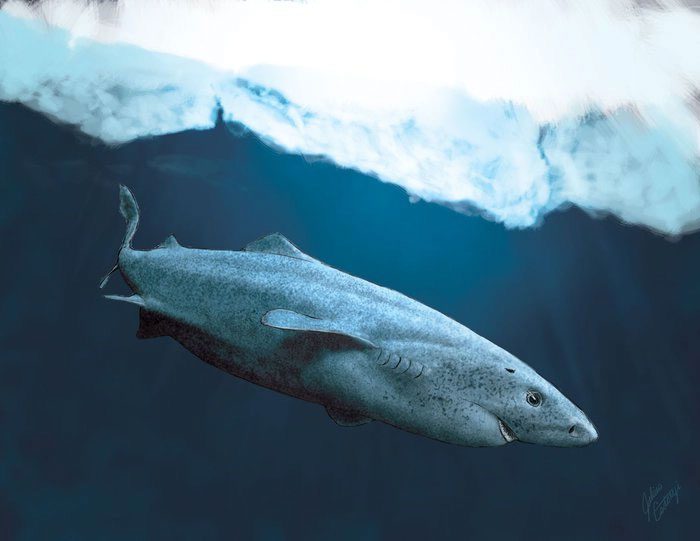
The Greenland shark is an apex predator in the depths of the ocean.
A Slow but Formidable Predator
Despite its slow movement, the Greenland shark is a formidable predator – an apex predator in the depths of the ocean. It preys on a variety of animals, from fish and seals to whales and even reindeer or horses. A dissected Greenland shark was found to have the remains of a polar bear in its stomach.
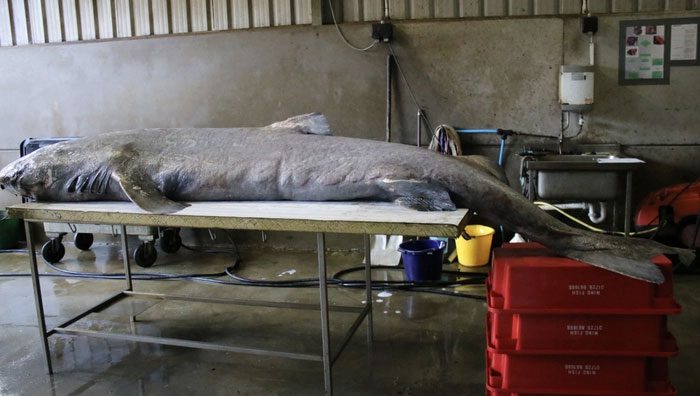
The Greenland shark is difficult to observe in its natural habitat.
It is unclear whether the Greenland shark hunts and kills all these prey or simply scavenges upon their carcasses when they fall into the ocean. There is some speculation that they might be a scavenger species. Scientists believe that this scavenging behavior, combined with their keen sense of smell, allows this species to survive in cold waters where there is not much prey. However, because Greenland sharks are very difficult to observe in their natural habitat, all conjectures lack solid scientific backing.
Nevertheless, the Greenland shark does not seem to shy away from attacking large creatures. There have been observations of a Greenland shark hunting a moose, although the size of the prey nearly caused it to choke (the shark was later rescued by humans).
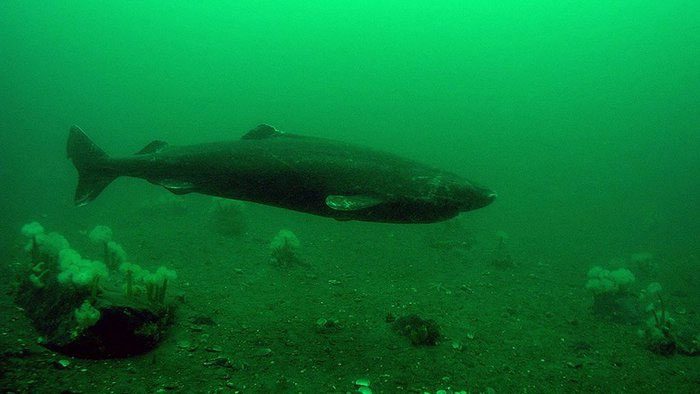
This shark species has 48-52 teeth in the upper jaw and 50-52 in the lower jaw.
Like most other shark species, once it identifies its prey, it does not easily give up the hunt. This shark species has 48-52 teeth in the upper jaw and 50-52 in the lower jaw – sharp teeth that help the shark hold onto larger prey. These sharks can move their heads in a circular motion. However, due to their slow swimming, it is likely they hunt sleeping prey.
Moreover, although considered an apex predator, the Greenland shark may not be safe from other predators. In particular, sperm whales (Physeter macrocephalus) seem to be a common threat to them. Greenland sharks have been observed fleeing when they hear the calls of sperm whales, and researchers have also found indirect evidence suggesting that some sperm whales frequently hunt Greenland sharks.
Greenland Sharks Can Live Beyond Greenland
The name of this species might mislead you. The Greenland shark, a solitary creature rarely seen in groups, is an excellent long-distance swimmer and has been spotted anywhere from Eastern Scandinavia to the Caribbean.
This shark species can also dive significantly deep, having been found in the Gulf of Mexico at a depth of 1,749 meters, where the water temperature is 4.1 degrees Celsius. This shark seems to rarely move below 1,500 meters, but it does not shy away from deep environments while searching for its preferred cold water habitat (between -0.6 to 12 degrees Celsius).
Despite its reputation for being aggressive and its large size, the Greenland shark is not a threat to humans. Although some cultures have stories of humans being attacked by Greenland sharks, there is no documented evidence of such occurrences (possibly because sharks prefer cold waters where people rarely swim). Additionally, Greenland sharks often actively avoid contact with humans.
According to some estimates, Greenland sharks can give birth to over 200 pups at once. These sharks are about 35 to 45 cm long when born, and as mentioned, it takes them over a century to mature enough to reproduce.
However, there is little additional information about their reproductive process – scientists still do not know how many of these pups survive.
The gestation period for this species is also very long: one study estimates a gestation time of 8 to 18 years, but this remains controversial as we do not have enough observational data on this species.
The Greenland shark is an incredibly unique species. Despite researchers’ efforts, it remains an intriguing and mysterious creature at the bottom of the deep ocean.
Researchers do not truly understand why these sharks live so long or what their relationships with other predators are like…
We have explored very few ocean mysteries, and it would be a shame to drive these animals extinct before we have a chance to fully understand them.


















































